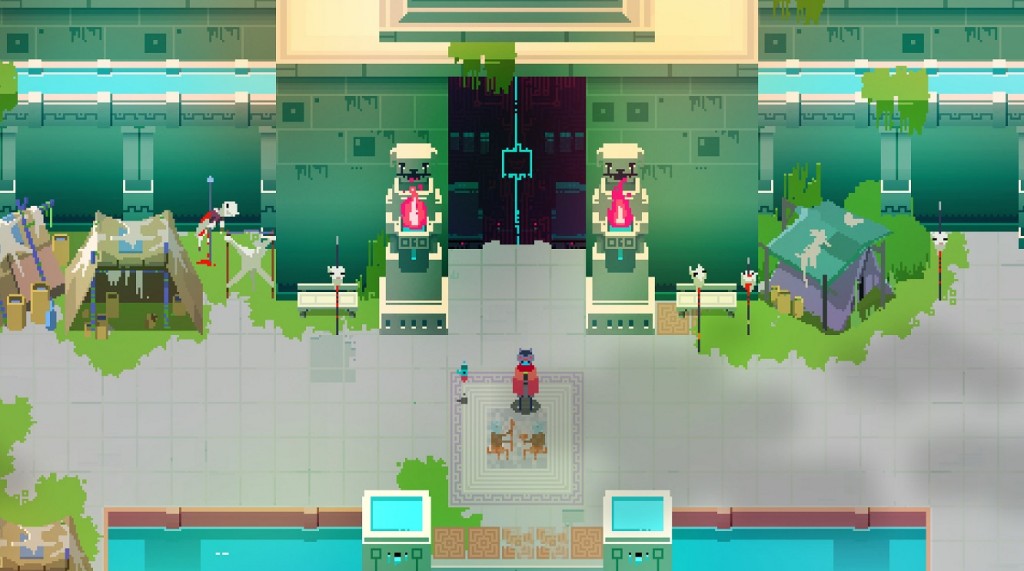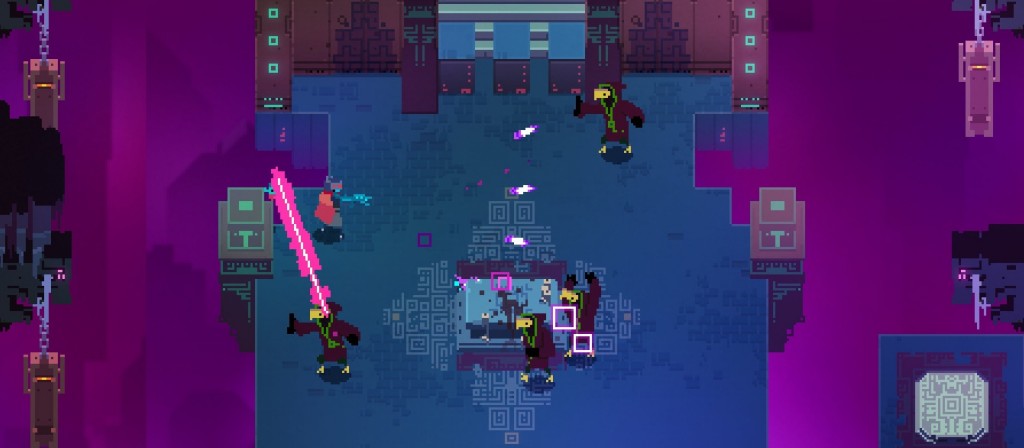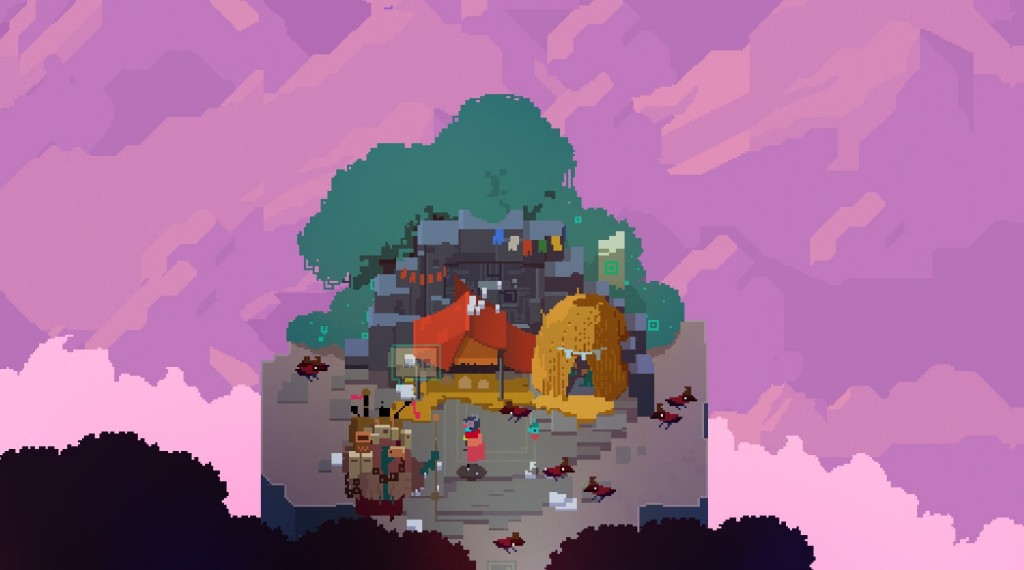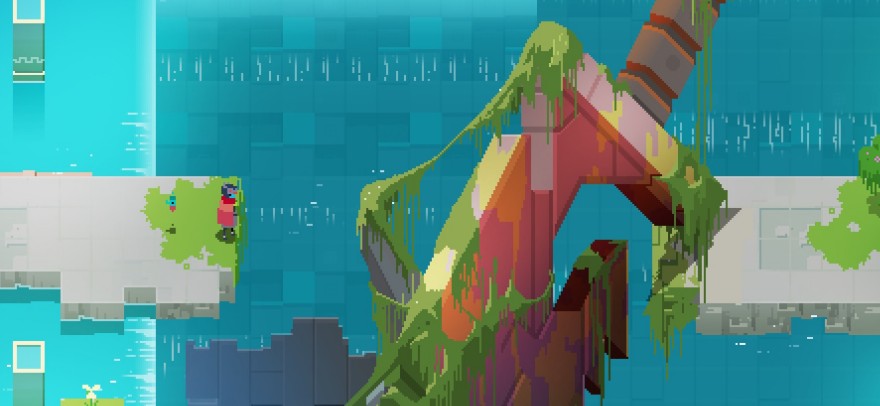Silence is difficult for most of us. It’s not just screens that prevent it, the ubiquity of entertainment and distraction, or the pace of modern life—though, that and more contributes to the difficulty of easing through the din. The chaff of life is a billowy recliner, keeping us cozy against the chaos in our minds. But there is something to gain in sitting in silence on a bare floor and using the low-cycle hum around you to pluck the signal from among scattered thoughts.
Hyper Light Drifter merges a sense of silence with what eventually becomes instinctive action. It’s a zen garden in an arena; a mostly ambient adventure game; a taut and nearly wordless journey that accentuates the top-down mystery of The Legend of Zelda (1986). It does this especially with its narrative and visual palette that evokes Polish director Krzysztof Kieslowski’s use of color and lingering lens.
You play as the eponymous Drifter, one of a few ronin wandering the ruins of one civilization while another is starting to fill in the void left behind. The story is primarily visual: as you meet locals they show you their tales through single-panel vignettes that detail the threats and travesties they’ve endured. As such, many of the beats are inferred. Where the drifter drifted in from is unclear, but he is constantly flashing back to an Akira (1988)-like explosion and a scene of menacing giants while intermittently coughing up fluorescent blood. It’s assumed you’re looking for a way to stop it all.

The stakes are large but the playable world is small and hushed, and to the game’s advantage—for the most part, you are left to explore at will with only a few barriers preventing entry to some spots meant for later. It’s a gnarled little knot of a place with four distinct sections spread evenly around a hub. It’s robust without being stretched thin, coiled tight like gray matter. This is why exploration never feels like busywork: repetition is minimized, the game instead encouraging you to be thorough so as to discover secrets that lead to a means to improve your moveset, but also to find vistas fit for for a brief moment of quietude that are impossible to stockpile. It is a game that wants to be contemplated extensively, for you to look and listen. And once an area has been charted you can dash back through, skeletons and corroded detritus whispering small stories as you pass, the only respite forced on you by cliffs arched with the mouldering corpses of golems, demanding that you utilize the “sit” button to take in the scenery.
Which isn’t to say that things don’t get busy: this isn’t a garden stroll made of pixels. To maintain equilibrium with the environmental exposition, Hyper Light Drifter offers tense and agile combat. The rhythms of the Batman Arkham series’ dance-battle flow are spliced with more traditional top-down sword-fighting and Mega Man Zero’s (2002) dashes; nimble zips across short distances that need to be metered for survival. Eventually you’ll cop a side arm, of which many varieties are offered through progress, and you can develop grenades as well as upgrades to these, your health, and your dash. Slash-mashing is the default tactic but it’s as uncivilized as splashing around in a koi pond. This game demands in battle what it offers in the more somber exploratory moments: clearing out the clamor of the mind in order to focus and strike clearly, especially when swarmed with enemies.
A pack of crystalline wolves that close in quickly should be dodged before countering. An army of shinobi frogs that can keep you from cinching the distance with a flurry of shurikens are best handled by singular sniping. Almost every enemy can take more than a few hits, from the vulture wizards and their strummed magic to the halberd-swinging footsoldiers, and they will all try to confound you with tumultuous ferocity. But you are capable of zeroing on your own signal and dashing around them like a spirograph—your agility helps with forgetting that failure will lead to a glitched-out demise. It’s a disparate but complementary orchestra of combat scenarios that can be tuned as necessary or desired, with the gun requiring swipes at enemies to recharge and the saber being just short enough to make close combat a calculated risk.

And by the time you get to the bigger bosses, you’d best be girded for an uproar that will almost certainly shatter your tranquility. They’re fast and savage, with health to spare, which makes the first few encounters with each wildly dispiriting. But these losses bring new intel on the patterns of their brutality, with telegraphs of what’s to come, teaching you what to anticipate rather than mindlessly dance around. It’s all discordantly quick, and that’s where the path of the sword comes into play—deduce their style and then dash in-and-out almost automatically, freeing all noisy thoughts in order to focus on pure action. Eventually, they will fall from a thousand whirring cuts. Combat is arduous but not cheap, a system thorough enough to offer several strategies without becoming overwhelming or a matter of rock-paper-scissors. You are as if a metronome, introducing a regular tick that helps straighten out the otherwise violent cacophony.
More so than anything else, the loom that weaves the fabric of Hyper Light Drifter is the sound. Early in each area, Disasterpeace’s music is slight and whispery, setting an ambience of exploration. This puts you in a meditative state that encourages you to poke around, to bathe in the rich glowing sunset and find those secrets. Doing so really taps into your exploratory impulses and the joys of dashing. As you hunt around, critters will interrupt, and the music adjusts accordingly. But the tracks never explicitly change: they shift, simmer, evolve, oscillate like the tide. Inching closer to the end of an area leads to a sonic throb but stops short of getting outright raucous, and even the boss fight tracks are tense but not intense. The soundtrack lulls and locks you in by avoiding the temptation to explicitly disrupt the established balance. Such sonority is practically radical in traditional adventure game space—this is not pendulous manipulation meant to keep the player swinging between extreme bipolarity, rather, it explores the nuance in a somewhat narrow spectrum and wrings nearly as much emotion from it.

Hyper Light Drifter plays with seconds of crisp silence and dramatic intervals like an opera. The visuals and atmospheric narrative lovingly conducts the eye through a neon-futurist aria that does occasionally feel maudlin, what with the frequent allusions to the proximity to death, but this is hardly unforgivable. Out of the void, Hyper Light Drifter meticulously crafts a post-apocalyptic samurai story, one that bends and folds the tenets of zen’s vivid ambience alongside the warrior path of bushido, something familiar yet fresh, quiet yet resonant.
For more about Kill Screen’s ratings system and review policy, click here.
